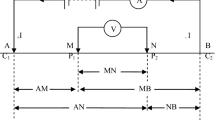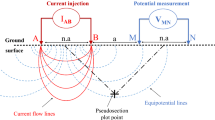Abstract
An accurate method of detecting wood decay and hollows or cavities in living trees is useful for risk assessment and maintenance of both forest and urban trees. This study presents the implementation of the four-point electrical resistivity method for the early detection of the presence, location and extent of wood decay and hollows in living acacia trees (Senna alata L.). Electrical resistivity measurement of randomly selected living acacia trees and a freshly-cut acacia tree with decay and hollows were taken to obtain electrical resistivity profiles for sound, decayed and hollowed trees. A laboratory experiment was set up to replicate the resistivity profiles. Wood decay and hollows were replicated at different depths in the laboratory prototype using good electrical conductors and insulators respectively. Resistivity profiles for the sound, decayed and hollowed trees were obtained from the experimental and field results. The resistivity profiles were applied to detect decay and hollows of similar dimensions in living trees through resistivity curve matching. The electrical resistivity of the decayed acacia tree was markedly lowered by an average factor of 5 compared to that of the sound acacia tree. Likewise, the electrical resistivity of the hollowed acacia tree was noticeably greater than that of the sound acacia tree by an average factor of 4. Wood decay and hollows modelled into the laboratory prototype were detected with relatively lower and higher resistivity anomalies respectively. The method indicated that 80% of the randomly selected living trees were sound, healthy trees, whilst 20% had decay and hollow at the time of measurements. This method is suitable for early detection of decay and hollows in hardwood trees.










Similar content being viewed by others
References
Beall F, Wilcox W (1987) Relationship of acoustic emission during radial compression to mass loss from decay. For Prod J 37:38–42
Bieker D, Rust S (2010) Non-destructive estimation of sapwood and heartwood width in Scots pine (Pinus sylvestris L.). Silva Fennica 44(2):267–273
Brazee NJ, Marra RE, Göcke L, Wassenaer PV (2010) Non-destructive assessment of internal decay in three hardwood species of northeastern North America using sonic and electrical impedance tomography. Forestry Adv. Access, Oxford
Butin H (1995) Tree diseases and disorders: causes, biology, and control in forest and amenity trees. Oxford University Press, Oxford, p 262
Goh CL, Rahim RA, Rahiman MHF, Talib MTM, Tee ZC (2018) Sensing wood decay in standing trees: a review. Sens Actuators A 269:276–282
Goncz B, Divos F, Bejo L (2018) Detecting the presence of red heart in beech (Fagus sylvatica) using electrical voltage and resistance measurements. Eur J Wood Prod 76(2):679–686
Guyot A, Ostergaard KT, Lenkopane M, Fan J, Lockington DA (2013) Using electrical resistivity tomography to differentiate sapwood from heartwood: application to conifers. Tree Physiol 33:187–194
Harris RW, Clark JR, Matheny NP (2004) Arboriculture: integrated management of landscape trees, shrubs, and vines, 4th edn. Prentice Hall, New Jersey
Herman R (2001) An introduction to electrical resistivity in geophysics. Am J Phys 69(9):943–952
Johnstone D, Moore G, Tausz M, Nicolas M (2010) The measurement of wood decay in landscape trees. Arboric Urban For 36(3):121–127
Kucera LJ (1985) Kernspintomographie und elektrische Widerstandsmessung als Diagnosemethoden der Vitalität erkrankter Bäume. Schweizerische Zeitschrift für Forstwesen (Magnetic resonance tomography and electrical resistance measurement as diagnostic methods of the disease-affected trees. Swiss J For 137(8):673–690 (in German)
Larsson B, Bengtsson B, Gustafsson M (2004) Nondestructive detection of decay in tree. Tree physiol 24:853–858
Manyazawale B, Ostrofsky WD (1992) An assessment of internal decay of red spruce (picea rubenssarg.) using the shigometer. Maine Agricultural Experiment Station Miscellaneous Report 369
Martin T, Günther T (2013) Complex resistivity tomography (CRT) for fungus detection on standing trees. Eur J Forest Res 132(5–6):765–776
Nicolotti G, Miglietta P (1998) Using high-technology instruments to assess defects in trees. J Arboric 24:297–302
Nicolotti G, Socco LV, Martinis R, Godio A, Sambuelli L (2003) Application and Comparison of three tomographic techniques for the detection of decay in trees. J Arboric 29:66–78
Ostrofsky WD, Shortle WC (1989) Application of the shigometer for assessing tree and forest health and wood product quality. Rev Trop Plant Pathol 6:39–57
Reynolds JM (2011) An introduction to applied and environmental geophysics, second edn. Wiley-Blackwell, London
Rinn F (1999) Device for Investigation Materials. US-Patent US6813948; International Patent. PCT/DE00/01467 (1999.05.11). Basic Patent Describing Sonic and Electrical Resistivity Tomographies
Shigo AL (1991) Modern arboriculture. Shigo & Trees, New Hampshire, p 421
Shortle WC (1990) Ionization of wood during previsual stages of wood decay. Biodeterior Res 3:333–348
Shortle WC, Smith KT (1987) Electrical properties and rate of decay in spruce and firwood. Phytopathology 77:811–814
Smith KT, Shortle WC (1988) Electrical resistance and wood decay by white rot fungi. Mycologia 80:124–126
Author information
Authors and Affiliations
Corresponding author
Additional information
Publisher’s Note
Springer Nature remains neutral with regard to jurisdictional claims in published maps and institutional affiliations.
Electronic supplementary material
Below is the link to the electronic supplementary material.
Rights and permissions
About this article
Cite this article
Soge, A.O., Popoola, O.I. & Adetoyinbo, A.A. A four-point electrical resistivity method for detecting wood decay and hollows in living trees. Eur. J. Wood Prod. 77, 465–474 (2019). https://doi.org/10.1007/s00107-019-01402-1
Received:
Published:
Issue Date:
DOI: https://doi.org/10.1007/s00107-019-01402-1




